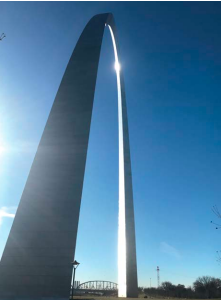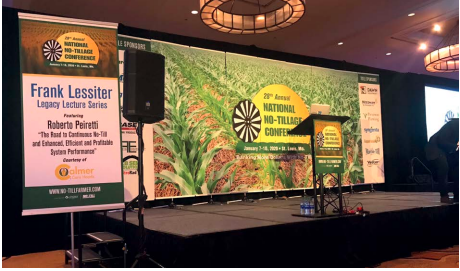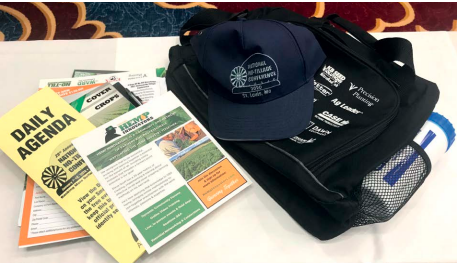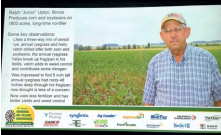Written by Andrew Jackson, Pink Pig Farm, Lincolnshire

I am a farmer from North Lincolnshire, amongst other things I have been described as butterfly and an evangelist, the former because I am always looking to land on something new which will improve my life and business, the latter because once I discovered regenerative farming, I felt compelled to learn more and to spread the word about its many benefits to friends and other farmers. I chose to attend the 2020 National No-Till Conference in St Louis USA because it is promoted by Lessiter media and I have read many of their publications and listen to their podcasts while field walking. After a 21-hour journey during which I was strongly advised by a kind lady on an internal flight “not to go downtown in St Louis”, due to the high homicide rate, I arrived at the Union Station Hotel only to find that the bar had just closed. It was 12.10am local time and 6.10 in the morning UK Time, my body was tired, and I retreated to bed.

I arrived a day early to avoid jet lag issues, I need not worried I woke up at the crack of dawn for a number of days. On my free day I explored St Louis and visited the National Blues Museum and the Gateway Arch, a 600 feet high stainless steel arch, completed in 1969, it is intended to promote the city’s position as the Gateway to the west for the settlers who passed through it, heading for the promised lands. St Louis was built on one of the major railroads which headed out West, it also sits at the confluence of the Mississippi and Missouri rivers, as such, it was and is, a major trading post and the hotel where the conference was hosted, displays the biggest hotel lobby that I have ever seen, due to the fact that it utilises the original train station ticket hall.
The average age of the farmer in the USA is slightly over sixty and like us they seem to have problems with the next generation coming into the farming business. There seemed to be plenty of farmers who had been practicing no-till for over thirty years, some of whom had received financial incentives from the state, however although some old timers claimed to have been using cover crops for many years, I got the impression that the wide spread introduction of cover crops was more recent.
Traditionally English farmers have worn flat caps and American farmers have worn baseball caps, I have made the observation that when inside a building it is very difficult to prise the baseball cap from some the American farmer’s heads, it is a fixture. They also like check shirts but with a slightly wider check spacing, a little something that I observed!
Most of the farmers at the conference were trapped into a twocourse rotation, not particularly out of choice, but because corn and soya were about the only crops which gave a financial return. They, like us were looking to break out and find a new financially rewarding crop. I did encounter one grower from Montana who was supplying Northern Pulse Growers with a variety of pulse crops, which were exported around the world. I mentioned that I knew a Canadian farmer who shut up shop in the winter and went to Florida, “Yes”, they said “that is known as a three-crop rotation, Soya, Corn and Florida!!!” On the Tuesday I attended a hemp growing seminar, this was mostly about growing hemp for CBD oils, which is currently illegal in the UK, the proceeds of the hemp harvest are distilled in a factory off the farm. Steve Groff highlighted the many hurdles that he had encountered growing, harvesting the hemp bushes and finding a secure outlet. This operation is not for the faint hearted, there is a lot of hard work and risk involved but the conclusion was that profit per acre generally fell between zero and $7000 per acre, although on a cautionary note, losses could be up to $20,000.
At supper that evening there was a discussion about banding cover crop seeds so that the following year’s maize seeds could be sewn into a less competitive band of radishes which are not winter hardy. Alongside the central row of radishes, crimson clover had been sown on both sides and furthest from the radish (where the maize seed is to be sown), are the hairy vetch and cereal rye which actually lie dead centre between the maize rows creating a firm base for all the tractor wheelings, and less competition for the cash crop.

Wednesday’s highlights included Jason Mauck, a farmer whom I have followed on Twitter, who explained his system of dual cropping winter wheat and soya beans, the idea being that the wheat is harvested earlier than the soya, and this then allows the soya greater access to sunlight. Another feature of this system is that the wheat provides shelter for the soya seedling, thus permitting the soya to be sown earlier than normal, providing an extended growing season. The consequences of which are, a small crop of wheat but a much bigger crop of soya, resulting in a greater net income. It’s all very scientific and I got the impression that it had worked in the trialling stage and he will roll out the system across his farm.
The other Wow was David Johnson who had been working on a Bioreactor, which is essentially an aerobic composter. The theory behind David’s work is that our soils have become dominated by bacteria and depleted in aerobic fungi. The composter is essentially a home-made tube, four feet diameter and about five feet high, it is filled with natural finely chopped material, (leaves, wood chip, hay). Air tunnels allow aerobic action and worms are introduced, the system is watered by one and a half gallons of rain water every day (ideally with an automated water system) and after one year, the end product should be seven hundred pounds of a black damp smooth compost which if his predictions are correct would in my opinion, have the equivalent value to gold. The beauty of this system is that it is low cost to set up and very low in labour requirements or fossil fuel usage.

The compost needs to be administered at one pound per acre, ideally by mixing into a slurry and placing next to the seed at drilling or mixing with the seed to form a seed dressing. David showed slides of how this product had brought desert land back to life and created exceptional maize plots with minimal use of fertilizer, all at the cost of twentyfive cents per acre. The idea was to re-introduce the aerobic fungi back into the soils, after which in a no-till situation they should multiply, as with human nature. I am tempted to build quite a few of these composters, in order to maybe increase the rate and apply the product every year. Another spin off, is that liquids, associated with this compost could be used as a fungicide, I guess that will come after more research, so we can look forward to another presentation from David. You can find David Johnson and his wife Hui Chun Su on YouTube at the sites shown below:
David Johnson Ecofarm Keynote (pretty much the same presentation that we received, although the sound quality is average)
Dr David Hui Chun Su Johnson (a small presentation on a farm, worth watching).
Johnson Su Composting Bioreactor (deals with the construction of the digester).
Smart Soil Ground Cover Ian and Dianne Haggerty (the Haggerty’s were mentioned in one of David Johnson’s presentations, so I found them on YouTube).
This bioreactor is being trialled on most continents and David Johnson and his wife welcome any feedback, which is most likely going to be in one and a half years, since the compost operation will take a whole year. Each day there were breakout groups when it was possible to choose a small discussion forum, for example I chose:
• Cover Crop Strategies in the North East, Mid Atlantic
• Winning ideas for no-tilling vegetables
• Solving the riddle of cover crops and fertilizer management
• Helpful hints for higher no-till wheat yields
• Using Mycorrhizae, humics, soil builders to unlock soil health.
The last one was hosted by James (Jim) Hoorman, Jim an retired government soil scientist had all the answers, the forum quickly moved from a group discussion, to a jaw dropping description from Jim on how the bacteria, microbes and fungi interact, to build fertility and access nutrition for the crop from the nutrients within the soil. There was so much knowledge coming out of his mind that is was difficult to keep up, I tried to make notes for future reference and understanding. Jim has set up his own consultancy company now and can be found at hoormansoilhealth.com

Jim also cautioned us, on how new high yielding varieties may not be so good at accessing nutrients from the fungi, he described modern varieties as being similar to a racehorse, when for what no-tillers want to achieve, utilising the soil biology and reducing manmade fertilisers, a work horse variety may be more appropriate. One way around this could be to keep your own seed back each year in the hope that that seed becomes familiar with finding the soil biology on your farm. On the final half day, once again I chose to listen to Jim Hoorman, this time about soil compaction, a powerful and entertaining speaker, he soon talked us out of getting into that tractor and cultivating the soil to alleviate compaction. He then once again broke down the functions of soil health into easy to understand comparables.
The last speaker who left an impact on me was Rob Myers, I had already stumbled across an excellent presentation by Rob on YouTube. Rob puts across the many benefits of cover cropping in an excellent, easy to understand format. He tried to assess the pay back period for the investment in cover crops, the conclusion was that farmers will generally lose money in the first year, break even in the second and arrive at a profitable situation in the third or fourth year. The take home message for me was that No-Till is only forty percent of the story, the other sixty percent is the cover cropping which encourages the dominance of fungi in the soil.
It is the fungi that work with the microbes, bacteria and protozoa to access nutrients for the plant. Only when these systems start to work efficiently can the fertiliser which is locked up in the soil become fully accessible and available. However, it is a catch 22, because by applying fertiliser the soil biology becomes lazy, so my conclusion, I would pull the plug on applying P and K straight away, however I have already purchased this year’s fertiliser, so I may split the P and K over two years.

Humus the organic matter which is responsible for holding and supplying the soil nutrients can only be built from dead rotting plants and animals. If farmed well in a mature no-till system, which is keeping the soil covered with cash and cover crops, then possibly 0.1% growth in organic matter, might be achieved each year, some farmers had exceeded this. All in all, I considered The National No-Till Conference to be well run, informative and hopefully value for money. The American farmers were hospitable and eager to communicate with me. I will definitely consider going another year.
The book reading for the trip was “Cows save the Planet”. I thought that it would provide me with a wealth of information to fight off vegans. Actually, it was more subtle than that, many things that the book described I already knew, and the book acted as a form of confirmation about what I had learnt from other books. However, there were some thought provoking chapters for a wannabe regenerative farmer, so I would recommend reading it